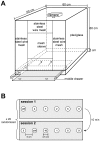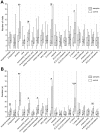Olfactory attraction of the hornet Vespa velutina to honeybee colony odors and pheromones
- PMID: 25549358
- PMCID: PMC4280141
- DOI: 10.1371/journal.pone.0115943
Olfactory attraction of the hornet Vespa velutina to honeybee colony odors and pheromones
Abstract
Since the beginning of the last century, the number of biological invasions has continuously increased worldwide. Due to their environmental and economical consequences, invasive species are now a major concern. Social wasps are particularly efficient invaders because of their distinctive biology and behavior. Among them, the yellow-legged hornet, Vespa velutina, is a keen hunter of domestic honeybees. Its recent introduction to Europe may induce important beekeeping, pollination, and biodiversity problems. Hornets use olfactory cues for the long-range detection of food sources, in this case the location of honeybee colonies, but the exact nature of these cues remains unknown. Here, we studied the orientation behavior of V. velutina workers towards a range of hive products and protein sources, as well as towards prominent chemical substances emitted by these food sources. In a multiple choice test performed under controlled laboratory conditions, we found that hornets are strongly attracted to the odor of some hive products, especially pollen and honey. When testing specific compounds, the honeybee aggregation pheromone, geraniol, proved highly attractive. Pheromones produced by honeybee larvae or by the queen were also of interest to hornet workers, albeit to a lesser extent. Our results indicate that V. velutina workers are selectively attracted towards olfactory cues from hives (stored food, brood, and queen), which may signal a high prey density. This study opens new perspectives for understanding hornets' hunting behavior and paves the way for developing efficient trapping strategies against this invasive species.
Conflict of interest statement
Figures



References
-
- Elton CS (1958) The Ecology of Invasions by Animals and Plants. Chicago, IL: University of Chicago Press.
-
- Vitousek PM, D’Antonio CM, Loope LL, Westbrooks R (1996) Biological invasions as global environmental change. Am Sc 84:468–478.
-
- Vitousek PM, Mooney HA, Lubchenco J, Melillo JM (1997) Human domination of Earth’s ecosystems. Science 277:494–499.
-
- Hochberg ME, Gotelli NJ (2005) An invasions special issue. Trends Ecol Evol 20:211.
-
- Park K (2004) Assessment and management of invasive alien predators. Ecol Soc 9:761–770.
Publication types
MeSH terms
Substances
LinkOut - more resources
Full Text Sources
Other Literature Sources

